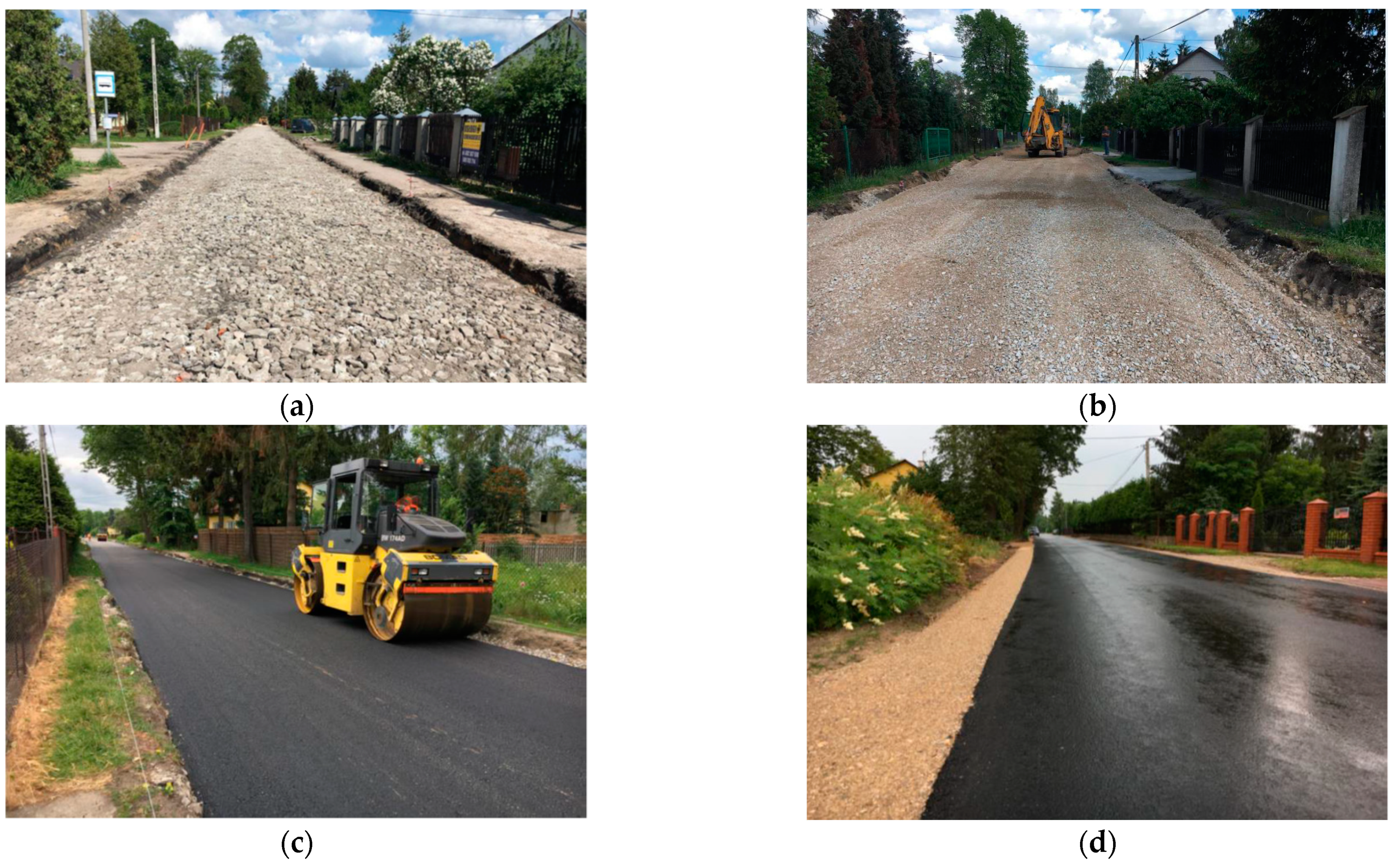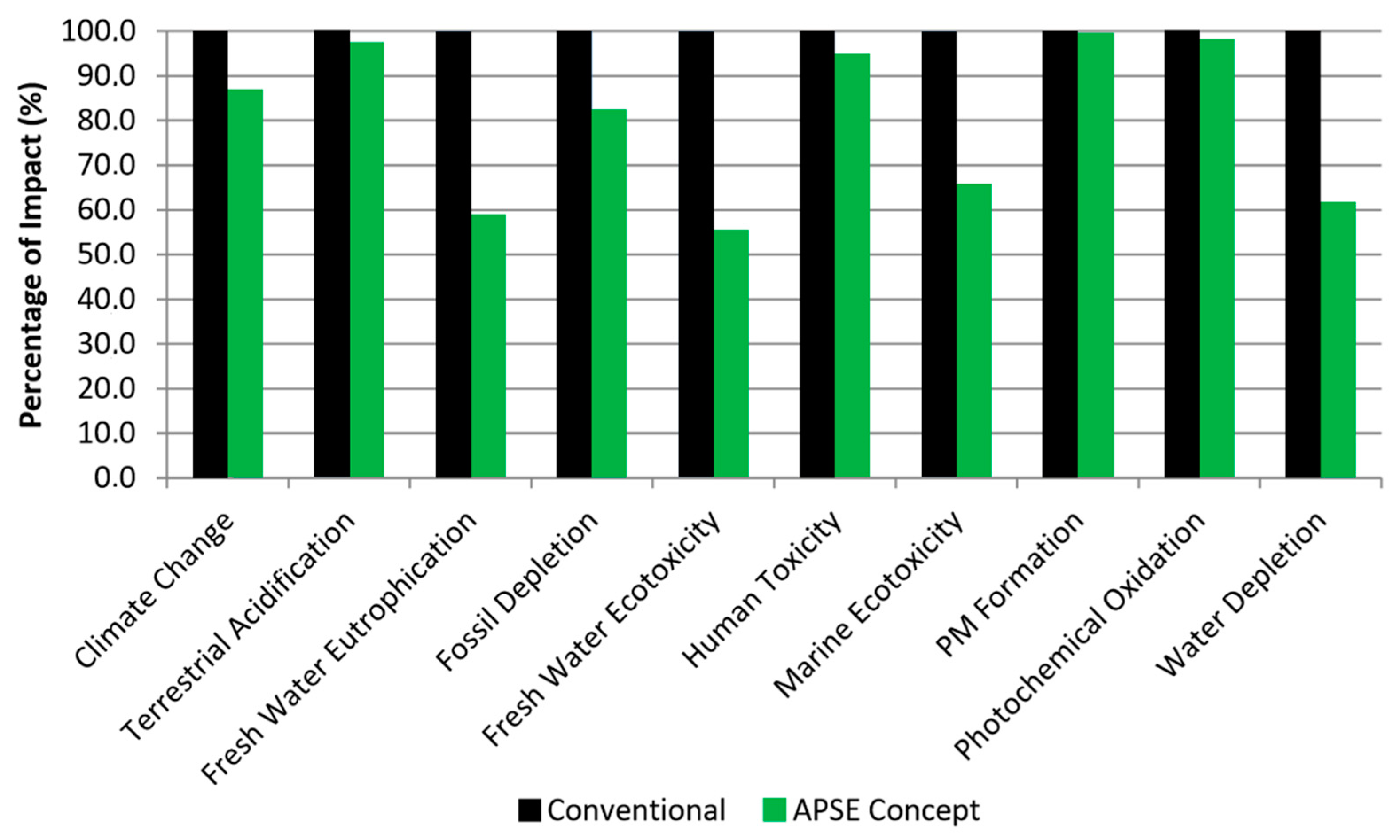Practical Application of Sustainable Road Structure: Mechanical and Environmental Approach
Abstract
1. Introduction
2. Study Approach
3. Materials, Testing Methods and Trial Sections
3.1. Materials Characteristics
3.2. Road Structure Trial Sections
3.3. Testing Methods
4. Mechanical Analysis
4.1. Laboratory Tests of the Complex Modulus and Fatigue Life
4.2. Loading Testing on Test Sections
- Nasf—fatigue life, (number of equivalent standard axles),
- εt—tensile strain, (μm/m),
- E—stiffness modulus, (MPa),
- Vb—asphalt content by volume, (%v/v),
- Va—air voids, (%v/v),
- hac—total thickness of bituminous layers, (cm)
- —parameter according to the formula:
- Ngr—life, (number of equivalent standard axles),
- εp—subgrade strain, (μm/m).
5. Economic and Environmental Analysis
5.1. Environmental Approach
5.2. Economic Analysis
5.3. SWOT Analysis and Market Outlook
6. Conclusions
Author Contributions
Funding
Data Availability Statement
Acknowledgments
Conflicts of Interest
References
- National Academies of Sciences Engineering & Medicine. Sustainable Highway Construction Guidebook; NASEM: Washington, DC, USA, 2019. [Google Scholar] [CrossRef]
- Huang, Y.; Hakim, B.; Zammataro, S. Measuring the carbon footprint of road construction using CHANGER. Int. J. Pavement Eng. 2013, 14, 590–600. [Google Scholar] [CrossRef]
- Manke, N.D.; Williams, R.C.; Sotoodeh-Nia, Z.; Cochran, E.W.; Porot, L.; Chailleux, E.; Lo Presti, D. Performance of a sustainable asphalt mix incorporating high RAP content and novel bio-derived binder. Road Mater. Pavement Des. 2019, 22, 812–834. [Google Scholar] [CrossRef]
- Xiao, R.; Huang, B. Moisture Damage Mechanism and Thermodynamic Properties of Hot-Mix Asphalt under Aging Conditions. ACS Sustain. Chem. Eng. 2022, 10, 14865–14887. [Google Scholar] [CrossRef]
- van de Ven, M.F.C.; Sluer, B.W.; Jenkins, K.J.; van den Beemt, C.M.A. New developments with half-warm foamed bitumen asphalt mixtures for sustainable and durable pavement solutions. Road Mater. Pavement Des. 2012, 13, 713–730. [Google Scholar] [CrossRef]
- Iwański, M.; Mazurek, G.; Buczyński, P. Bitumen Foaming Optimisation Process on the Basis of Rheological Properties. Materials 2018, 11, 1854. [Google Scholar] [CrossRef] [PubMed]
- Al Zubaidy, I.A.H.; Al-Tamimi, A.K. Production of sustainable pavement with oil sludge. Road Mater. Pavement Des. 2014, 15, 691–700. [Google Scholar] [CrossRef]
- Leandri, P.; Rocchio, P.; Losa, M. A SWOT analysis of innovative high sustainability pavement surfaces containing crumb rubber modifier. Road Mater. Pavement Des. 2020, 21, S103–S122. [Google Scholar] [CrossRef]
- Santos, J.; Ferreira, A.; Flintsch, G. A life cycle assessment model for pavement management: Methodology and computational framework. Int. J. Pavement Eng. 2015, 16, 268–286. [Google Scholar] [CrossRef]
- Santos, J.; Torres-Machi, C.; Morillas, S.; Cerezo, V. A fuzzy logic expert system for selecting optimal and sustainable life cycle maintenance and rehabilitation strategies for road pavements. Int. J. Pavement Eng. 2020, 23, 425–437. [Google Scholar] [CrossRef]
- Hamdar, Y.S.; Kassem, H.A.; Chehab, G.R. Using different performance measures for the sustainability assessment of asphalt mixtures: Case of warm mix asphalt in a hot climate. Road Mater. Pavement Des. 2020, 21, 1–24. [Google Scholar] [CrossRef]
- Varma, S.; Jamrah, A.; Kutay, M.E.; Korkmaz, K.A.; Haider, S.W.; Buch, N. A framework based on engineering performance and sustainability to assess the use of new and recycled materials in pavements. Road Mater. Pavement Des. 2019, 20, 1844–1863. [Google Scholar] [CrossRef]
- Casado Barrasa, R.; Martín-Portugués Montoliu, C.; Kowalski, K.J.; Król, J.B. Field evaluation of a sustainable road structure concept. In Bituminous Mixtures and Pavements VII.; CRC Press: Boca Raton, FL, USA, 2019; pp. 448–456. [Google Scholar] [CrossRef]
- Kowalski, K.J.; Król, J.B.; Bańkowski, W.; Radziszewski, P.; Sarnowski, M. Thermal and fatigue evaluation of asphalt mixtures containing RAP treated with a bio-agent. Appl. Sci. 2017, 7, 216. [Google Scholar] [CrossRef]
- Król, J.B.; Kowalski, K.J.; Niczke, Ł.; Radziszewski, P. Effect of bitumen fluxing using a bio-origin additive. Constr. Build. Mater. 2016, 114, 194–203. [Google Scholar] [CrossRef]
- Król, J.B.; Niczke, Ł.; Kowalski, K.J. Towards understanding the polymerization process in Bitumen bio-fluxes. Materials 2017, 10, 1058. [Google Scholar] [CrossRef] [PubMed]
- Niczke, L.; Czechowski, F.; Gawel, I. Oxidized rapeseed oil methyl ester as a bitumen flux: Structural changes in the ester during catalytic oxidation. Prog. Org. Coat. 2007, 59, 304–311. [Google Scholar] [CrossRef]
- National Academies of Sciences, Engineering, and Medicine. Validating the Fatigue Endurance Limit for Hot Mix Asphalt; The National Academies Press: Washington, DC, USA, 2010. [Google Scholar] [CrossRef]
- Francken, L. Bituminous Binders and Mixes: State of the Art and Interlaboratory Tests on Mechanical Behaviour and Mix Design; E & FN Spon: London, UK, 1998. [Google Scholar]
- Bańkowski, W. Analysis of fatigue life of asphalt concretes considering different types of mixtures and binders. Roads Bridges-Drog. I Mosty 2018, 17, 253–270. [Google Scholar] [CrossRef]
- Bańkowski, W. Evaluation of Fatigue Life of Asphalt Concrete Mixtures with Reclaimed Asphalt Pavement. Appl. Sci. 2018, 8, 469. [Google Scholar] [CrossRef]
- Sybilski, D.; Bańkowski, W. Energetic method as an alternative for conventional method in fatigue life analysis of bituminous mixtures. In Proceedings of the 4th International SIIV Congress Advances in Transport Infrastructures and Stakeholders Expectations, Palermo, Italy, 12–14 September 2007. [Google Scholar]
- Bańkowski, W.; Król, J.; Gałązka, K.; Liphardt, A.; Horodecka, R. Design and verification of bituminous mixtures with the increased content of reclaimed asphalt pavement. IOP Conf. Ser. Mater. Sci. Eng. 2018, 356, 012009. [Google Scholar] [CrossRef]
- Graczyk, M.; Rafa, J.; Mechowski, T.; Sudyka, J.; Chomicki, M. Method of estimation of bearing capacity of multi-layer pavements with application of quasi-static tests. In Proceedings of the 6th International Conference on the Bearing Capacity of Roads, Railways and Airfields, Lisbon, Portugal, 24–26 June 2002; Available online: https://www.researchgate.net/publication/316456438 (accessed on 1 May 2020).
- Judycki, J.; Jaskuła, P.; Pszczoła, M.; Ryś, D.; Jaczewski, M.; Alenowicz, J.; Stienss, M. New polish catalogue of typical flexible and semi-rigid pavements. XI International Road Safety Seminar GAMBIT 2016. MATEC Web Conf. 2017, 122. [Google Scholar] [CrossRef]
- Eckmann, B.; Gastmans, A. Noah–Computer Software for Pavement Design Calculations; European Asphalt Pavement Association: Brussels, Belgium, 1995. [Google Scholar]
- Huijbregts, M.A.J.; Steinmann, Z.J.N.; Elshout, P.M.F.; Stam, G.; Verones, F.; Vieira, M.; van Zelm, R. ReCiPe2016: A harmonised life cycle impact assessment method at midpoint and endpoint level. Int. J. Life Cycle Assess. 2017, 22, 138–147. [Google Scholar] [CrossRef]
- GaBi Life Cycle Analysis Software/Databases; Sphera Solutions GmBH Gesellschaft mit beschränkter Haftung: Leinfelden-Echterdingen, Germany, 2017.
- Blomberg, T.; Barnes, J.; Bernard, F.; Dewez, P.; le Clerc, S.; Pfitzmann, M.; Taylor, R. Life Cycle Inventory: BITUMEN. 2012. Available online: https://www.eurobitume.eu/fileadmin/pdf-downloads/LCI%20Report-Website-2ndEdition-20120726.pdf (accessed on 1 May 2020).
- Franklin; Andrews. CESMM3 Carbon & Price Book 2011; Thomas Telford Publishing: London, UK, 2010. [Google Scholar] [CrossRef]
- ISO 15686-5:2017(en); Buildings and Constructed Assets—Service Life Planning—Part 5: Life-Cycle Costing. International Organization for Standardization: Geneva, Switzerland, 2017. Available online: https://www.iso.org/obp/ui/#iso:std:iso:15686:-5:ed-2:v1:en (accessed on 1 May 2020).
- Sartori, D.; Catalano, G.; Genco, M.; Pancotti, C.; Sirtori, E.; Vignetti, S.; del Bo, C. Guide to Cost-Benefit Analysis of Investment Projects for Cohesion Policy 2014–2020. 2014. Available online: https://ec.europa.eu/regional_policy/en/information/publications/guides/2014/guide-to-cost-benefit-analysis-of-investment-projects-for-cohesion-policy-2014-2020 (accessed on 1 May 2020).










| Properties | Base Course AC 22 | Binder Course AC 22 | ||||
|---|---|---|---|---|---|---|
| Reference Mixture | Standard Section | APSE Experimental Section | Reference Mixture | Standard Section | APSE Experimental Section | |
| RAP content, % | 0 | 20 | 30 | 0 | 20 | 30 |
| Bitumen type | 35/50 | 35/50 | 35/50 +2.5% BIO | 35/50 | 35/50 | 35/50 +2.5% BIO |
| Extracted binder, % | 3.9 | 3.6 | 3.6 | 4.2 | 3.9 | 4.2 |
| Bulk density, ρb (Mg/m3) | 2.478 | 2.473 | 2.478 | 2.472 | 2.458 | 2.490 |
| Maximum density, ρm (Mg/m3) | 2.591 | 2.612 | 2.604 | 2.612 | 2.613 | 2.619 |
| Air voids, Vm (%) | 4.4 | 5.3 | 4.8 | 4.8 | 5.9 | 4.9 |
| Core air voids, % | --- | 5.0 | 4.5 | --- | 5.5 | 5.0 |
| Strain, µm/m | Pavement Structure and Year | |||
|---|---|---|---|---|
| Reference 2017 | Reference 2018 | Experimental 2017 | Experimental 2018 | |
| εa | 118.0 | 103.7 | 156.6 | 116.2 |
| εg | 385.0 | 333.5 | 484.2 | 376.3 |
| Life criteria | Design life, mln of 100 kN Esals | |||
| Na | 3.2 | 4.6 | 1.8 | 3.9 |
| Ng | 2.7 | 5.2 | 1.0 | 3.0 |
| Nmin | 2.7 | 4.6 | 1.0 | 3.0 |
| INTERNAL | STRENGTHS | WEAKNESSES |
| BIO-additive allowing for a higher RAP utilisation. APSE concept a remarkable improved LCA profile compared to the conventional paving. APSE solution up to 25% cheaper than the conventional paving concept. The use of CDW supports implementation of the Waste Directive. | Relatively high price of BIO-additive due to the use of relatively high raw materials prices and processing costs. Market readiness of the green APSE road paving concept. Agreement and availability of resources to go full in for the commercialisation of the APSE concept and/or individual KER (e.g., BIO-additive, CDW aggregates). | |
| EXTERNAL | Very positive legislative drivers concerning the use of waste for secondary raw material, circular economy, etc. (in Europe and US). Market focus on LCA performance, high use of RAP and recycling or aggregates (in Europe and US). High market demand for bitumen in Asian markets, where price could become an issue which will benefit RAP usage. | Competing environmentally friendly road paving concepts, e.g., warm mix asphalt, noise reduction, other bitumen substitution solutions. Continuation of the economic crisis in Europe, combined with declining demand for road transport due to swift between transport modes, e.g., freight to trails, passengers to public transport. Green demands become less politically interesting.Global recession slowing new infrastructure investments. |
| OPPORTUNITIES | THREATS |
Publisher’s Note: MDPI stays neutral with regard to jurisdictional claims in published maps and institutional affiliations. |
© 2022 by the authors. Licensee MDPI, Basel, Switzerland. This article is an open access article distributed under the terms and conditions of the Creative Commons Attribution (CC BY) license (https://creativecommons.org/licenses/by/4.0/).
Share and Cite
Kowalski, K.J.; Bańkowski, W.; Król, J.B.; Andersen, B.H.; Komkova, A.; Casado Barrasa, R. Practical Application of Sustainable Road Structure: Mechanical and Environmental Approach. Appl. Sci. 2022, 12, 11914. https://doi.org/10.3390/app122311914
Kowalski KJ, Bańkowski W, Król JB, Andersen BH, Komkova A, Casado Barrasa R. Practical Application of Sustainable Road Structure: Mechanical and Environmental Approach. Applied Sciences. 2022; 12(23):11914. https://doi.org/10.3390/app122311914
Chicago/Turabian StyleKowalski, Karol J., Wojciech Bańkowski, Jan B. Król, Birgitte Holt Andersen, Anastasija Komkova, and Raquel Casado Barrasa. 2022. "Practical Application of Sustainable Road Structure: Mechanical and Environmental Approach" Applied Sciences 12, no. 23: 11914. https://doi.org/10.3390/app122311914
APA StyleKowalski, K. J., Bańkowski, W., Król, J. B., Andersen, B. H., Komkova, A., & Casado Barrasa, R. (2022). Practical Application of Sustainable Road Structure: Mechanical and Environmental Approach. Applied Sciences, 12(23), 11914. https://doi.org/10.3390/app122311914






